Grotte des Combarelles
Useful Information



| Location: |
D47, 17 km north of Bergerac, 2.3 km east of Les Eyzies-de-Tayac.
Tickets sold at Grotte de Font-de-Gaume, 1 km from the centre of Les Eyzies-de-Tayac on the left side of the Beune valley. (44.943600, 1.042220) |
| Open: |
15-MAY to 15-SEP Mon-Fri, Sun 9:30-17:30. 16-SEP to 14-MAY Mon-Fri, Sun 9:30-12:30, 14-17:30. Closed 01-JAN, 01-MAY, 01-NOV, 11-NOV, 25-DEC. [2021] |
| Fee: |
Adults EUR 11.50, Children (0-17) free, Reduced EUR 4.50, Adults (18-25) from the EU free, Disabled free, Unemployed free. Groups (20+): Adults EUR 5.50. [2011] |
| Classification: |
 Karst Cave Karst Cave
|
| Light: |
 Electric Light Electric Light
|
| Dimension: |
L=300, T=12 °C, H=99%. Combarelles I: L= 249 m. |
| Guided tours: | L=400 m, D=60 min, Max=6, Max=60/day. |
| Photography: | forbidden |
| Accessibility: | no |
| Bibliography: | |
| Address: | Grotte des Combarelles, Hall d’accueil de Font-de-Gaume, Route de Sarlat, 24620 Les Eyzies-de-Tayac, Tel: +33-553-068600. |
| As far as we know this information was accurate when it was published (see years in brackets), but may have changed since then. Please check rates and details directly with the companies in question if you need more recent info. |
|
History
| 1891 | entrance area excavated by Emile River. |
| 1894 | end of excavations by Emile River. |
| 08-SEP-1901 | engravings discovered by Denis Peyrony, Abbe Breuil and Louis Capitan. |
| 1902 | the prehistoric age of the Altamira paintings recognized as a result of the discoveries at Combarelles, public apology by Abbe Breuil. |
| 12-DEC-1902 | Combarelles I classified as historical monuments. |
| 1909 | excavation by Émile River. |
| 24-SEP-1943 | Combarelles II registered as historical monuments by decree. |
| 1973 | C-14 dating of bones. |
| 1979 | inscribed on the UNESCO World Heritage List. |
| 2005 | Combarelles III discovered by Marc Delluc at the end of Combarelles I. |
Description
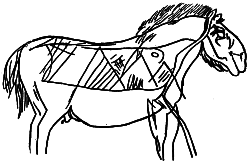
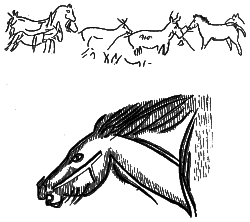

The Grotte des Combarelles or simply Les Combarelles is located a few kilometers east of Les Eyzies-de-Tayac. The huge entrance portal was known since ancient times. The entrance area was excavated by Emile River between 1891 and 1894. Bones, excavated in this area were dated with the C-14 method in 1973 to be between 11,380 and 13,680 years old.
The engravings in the narrow passage behind the huge portal were discovered by Denis Peyrony, Abbe Breuil and Louis Capitan on 08-SEP-1901. They were travelling around the area at this time to identify prehistoric remains. Four days later they discovered the paintings at nearby Font-de-Gaume Cave. It was a time, when the age of cave paintings was impossible to determine. There were no modern geophysical isotope based methods, the age was derived from a theory of the development of modern art. According to this theory old paintings were made by less developed human ancestors and were thus less elaborate, so the age was estimated propotional to the quality of the artworks. 20 years earlier Maria, the daugther of Marcelino de Santuola, discovered paintings of bisons at the ceiling of the Altamira Cave which was owned by the family. The cave paintings were so elaborate, that archaeologists of this time, including the world famous Abbe Breuil, questioned a higher age. The owner of Altamira cave was blamed to have faked the paintings. But the discoveries at Combarelles changed anything! The engravings were covered by speleothems, and knowing the growth rate of speleothems, an age much higher as ever before was calculated. As a result Abbe Breuil publicly appologized for his doubts. Unfortunately Marcelino de Santuola had already died
But like often, the fame of Combarelles was short. Only four days later the archaeologists discovered nearby Grotte de Font-de-Gaume and the colourful drawings made the - sometimes hard to see - engravings much less popular. Probably a good thing, as this is actually the reason that Combarelles was never overcrowded, and never closed to the public. Until today it is rather simple to get tickets, even when other caves are booked out.
While the porch is huge and opens to a sort of natural amphitheatre, the cave itself is quite small. The passage is only one meter wide and was originally very low, so it was necessary to crawl. The floor was lowered when the cave was developed as a show cave, so today the visit is a sort of stooping walk. Actually there are two passages in opposite direction, called Combarelles I and Combarelles II. In 2005 Marc Delluc discovered a new gallery at the end of Combarelles I, which is called Combarelles III. To protect the engravings the number of visitors is limited to 60 per day. Also it is not allowed to touch the wall at any point and the groups are limited to 6 visitors. On the tour the first 200 m of Combarelles I are visited, the tour returns on the same way. Because of the narrow and low passage the tour is rather strenuous, and certainly not suitable for people with claustrophobia.
The cave contains some 600 etchings and a few drawings in black outlines. They show mostly animals, including reindeers, musk oxen, horses, bisons, and aurochs (wild oxen). Some show rather abstract anthropomorphic figures which are interpreted as female forms. A few geometric patterns are called tectiforms. The art is of Magdalènien age, between 13,680 and 11,380 BP, in other words the cave was used only for short time, but this "short" period was nevertheless 2000 years long.
- See also
 Subterranean World Heritage List
Subterranean World Heritage List Search DuckDuckGo for "Grotte des Combarelles"
Search DuckDuckGo for "Grotte des Combarelles" Google Earth Placemark
Google Earth Placemark Grotte des Combarelles - Wikipédia (visited: 01-MAR-2011)
Grotte des Combarelles - Wikipédia (visited: 01-MAR-2011) Prehistoric Sites and Decorated Caves of the Vézère Valley - UNESCO World Heritage List
Prehistoric Sites and Decorated Caves of the Vézère Valley - UNESCO World Heritage List Les Eyzies-de-Tayac - Centre des monuments nationaux, official website (visited: 02-MAR-2011)
Les Eyzies-de-Tayac - Centre des monuments nationaux, official website (visited: 02-MAR-2011) Grotte des Combarelles 1 Cave or Rock Shelter : The Megalithic Portal and Megalith Map: (visited: 01-MAR-2011)
Grotte des Combarelles 1 Cave or Rock Shelter : The Megalithic Portal and Megalith Map: (visited: 01-MAR-2011) Don’s Maps: Les Combarelles in the Dordogne (visited: 26-MAY-2021)
Don’s Maps: Les Combarelles in the Dordogne (visited: 26-MAY-2021) Combarelles - grotte - visite - images - Hominidés
Combarelles - grotte - visite - images - Hominidés
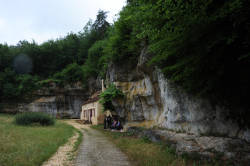
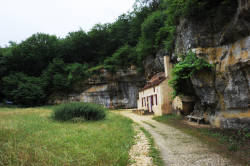
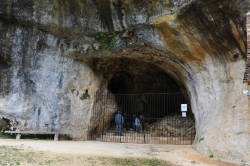

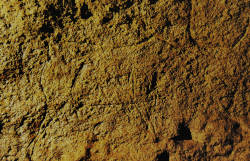
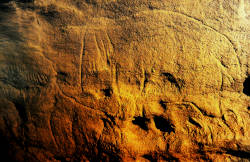
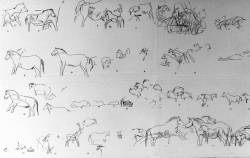
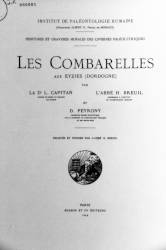
 Index
Index Topics
Topics Hierarchical
Hierarchical Countries
Countries Maps
Maps